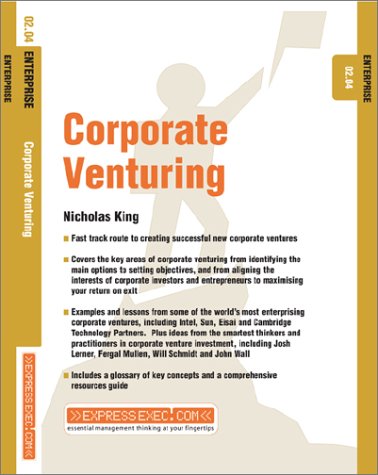

Most ebook files are in PDF format, so you can easily read them using various software such as Foxit Reader or directly on the Google Chrome browser.
Some ebook files are released by publishers in other formats such as .awz, .mobi, .epub, .fb2, etc. You may need to install specific software to read these formats on mobile/PC, such as Calibre.
Please read the tutorial at this link: https://ebookbell.com/faq
We offer FREE conversion to the popular formats you request; however, this may take some time. Therefore, right after payment, please email us, and we will try to provide the service as quickly as possible.
For some exceptional file formats or broken links (if any), please refrain from opening any disputes. Instead, email us first, and we will try to assist within a maximum of 6 hours.
EbookBell Team

4.1
30 reviews
ISBN 13: 9781841123707
Author: Nicholas King
ExpressExec is a unique business resource of one hundred books. These books present the best current thinking and span the entire range of contemporary business practice. Each book gives you the key concepts behind the subject and the techniques to implement the ideas effectively, together with lessons from benchmark companies and ideas from the world's smartest thinkers.
Part I: The Foundations of Corporate Venturing
Chapter 1: The Corporate Venturing Imperative
1.1 The Challenge of Disruption and the Need for Strategic Renewal
1.2 Defining Corporate Venturing: Beyond R&D
1.3 Key Benefits: Access to New Markets, Technologies, and Talent
1.4 The Risks and Challenges of Corporate Venturing
1.5 Corporate Venturing vs. Traditional Venture Capital (VC)
1.6 The Rise of Corporate Venturing in the Global Economy
Chapter 2: Typologies and Models of Corporate Venturing
2.1 The Corporate Venturing Continuum: Internal vs. External
2.2 Internal Venturing: Fostering Intrapreneurship
2.2.1 Innovation Labs and Hubs
2.2.2 Corporate Accelerators and Incubators
2.2.3 Venture Builders
2.3 External Venturing: Engaging with the Ecosystem
2.3.1 Corporate Venture Capital (CVC)
2.3.2 Strategic Alliances and Partnerships
2.3.3 Mergers and Acquisitions (M&A)
2.3.4 Venture Clienting
2.4 Hybrid Models and Portfolio Approaches
Part II: Building and Operating a Corporate Venturing Program
Chapter 3: Strategy and Governance
3.1 Aligning Venturing with Corporate Strategy and Long-Term Goals
3.2 Defining Clear Objectives: Strategic vs. Financial Returns
3.3 Establishing a Governance Framework
3.3.1 Roles and Responsibilities of a Dedicated Team
3.3.2 Decision-Making Processes and Investment Criteria
3.3.3 Balancing Autonomy and Corporate Control (the "Freedom-Balance" Tense)
Chapter 4: The Venturing Process
4.1 Opportunity Identification and Idea Generation
4.1.1 Uncovering Market White Space
4.1.2 Internal vs. External Sourcing
4.2 Concept Validation and Due Diligence
4.2.1 Problem-Solution Fit and Market Traction
4.2.2 Assessing the Team and Business Plan
4.3 Investment and Implementation Structures
4.3.1 Equity Investments and Convertible Notes
4.3.2 Shared Resources and Synergies
4.4 Portfolio Management and Value Creation
4.4.1 Active vs. Passive Management
4.4.2 Leveraging Corporate Assets (expertise, network, customer base)
4.4.3 Facilitating Internal Integration and Collaboration
Chapter 5: People and Culture
5.1 Building an Entrepreneurial Team
5.1.1 The Role of the Venture Lead
5.1.2 Attracting and Retaining Entrepreneurial Talent
5.2 Incentives and Motivation
5.2.1 KPI-driven Bonuses and Equity Shares
5.3 Fostering an Innovation Culture
5.3.1 Embracing Risk-Taking and Experimentation
5.3.2 Managing Internal Competition and Resistance
Part III: Measurement, Challenges, and Future Directions
Chapter 6: Metrics for Success
6.1 Moving Beyond ROI: A Balanced Scorecard Approach
6.2 Key Performance Indicators (KPIs) Across the Venture Lifecycle
6.2.1 Conceptualization and Validation Metrics (Learning and Testing)
6.2.2 Growth and Scaling Metrics (Traction and Market Penetration)
6.2.3 Financial and Strategic Metrics (Revenue, ROI, Synergies)
6.3 Reporting and Communication with Stakeholders
Chapter 7: Common Challenges and Pitfalls
7.1 Balancing Venture Speed with Corporate Governance
7.2 Resource Allocation Tensions
7.3 Managing Intellectual Property (IP) and Data
7.4 Exiting the Corporate Venture: Mergers, Acquisitions, and Spin-offs
Chapter 8: The Future of Corporate Venturing
8.1 The Rise of Venture Building and Strategic Option Creation
8.2 The Role of AI and Digital Tools in Opportunity Identification
8.3 Corporate Venturing in a VUCA (Volatile, Uncertain, Complex, Ambiguous) World
8.4 Case Studies and Best Practices from Industry Leaders
corporate venturing
which of the following is alternatively called corporate venturing
global corporate venturing
internal corporate venturing
which of the following is true of corporate venturing
Tags: Nicholas King, Corporate, Venturing